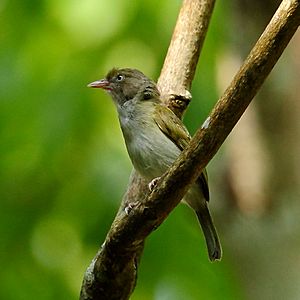Grey-chested greenlet facts for kids
Quick facts for kids Grey-chested greenlet |
|
|---|---|
 |
|
| at Iranduba, Amazonas state, Brazil | |
| Conservation status | |
| Scientific classification | |
| Genus: |
Hylophilus
|
| Species: |
semicinereus
|
 |
|
The grey-chested greenlet (Hylophilus semicinereus) is a small bird that lives in warm, wet parts of South America. It belongs to the Vireonidae family, which includes other greenlets and vireos. This bird gets its name from the grey color on its chest, which stands out against its greenish back.
You can find the grey-chested greenlet in several countries. These include Bolivia, Brazil, Colombia, French Guiana, Peru, and Venezuela. It prefers to live in places with lots of trees and plants.
Contents
What is a Grey-chested Greenlet?
The grey-chested greenlet is a small, active bird. It is known for its quiet movements through the forest canopy. These birds are often hard to spot because their green feathers help them blend in with the leaves. They are part of a group of birds called greenlets. Greenlets are known for their simple songs and their habit of looking for insects among the leaves.
Where Does It Live?
This bird's favorite places to live are moist lowland forests. These are forests that are not very high up and get a lot of rain. They also live in areas where forests have been cut down but are now growing back. These areas are called "heavily degraded former forest." This shows that the grey-chested greenlet can adapt to some changes in its habitat.
The grey-chested greenlet is a bird of the Amazon rainforest. This huge forest covers a large part of South America. The bird finds food and builds its nests among the many trees and plants there.
What Does It Eat?
Like most greenlets, the grey-chested greenlet mainly eats insects. It moves through the leaves and branches, looking for small bugs, caterpillars, and other tiny creatures. Eating insects helps control insect populations in the forest. Sometimes, they might also eat small fruits or berries they find.
How Does It Behave?
Grey-chested greenlets are usually seen alone or in pairs. They often join mixed-species flocks. These are groups of different bird species that travel and feed together. This can help them find food more easily and stay safe from predators.
They are not very loud birds. Their calls are usually simple and repetitive. They use these calls to communicate with each other or to mark their territory.
Life Cycle and Reproduction
Birds like the grey-chested greenlet build cup-shaped nests. They usually place these nests in the forks of tree branches or hidden among dense leaves. Both the male and female birds help to build the nest.
The female bird lays a few eggs, which are usually small and pale. Both parents take turns sitting on the eggs to keep them warm until they hatch. Once the chicks hatch, they are tiny and helpless. The parent birds work hard to feed them insects until they are big enough to leave the nest and fly on their own.
Conservation Status
The grey-chested greenlet is listed as "Least Concern" (LC) by the International Union for Conservation of Nature (IUCN). This means that its population is currently stable. It is not considered to be at high risk of extinction.
However, like many forest birds, its habitat is still threatened by deforestation. This is when large areas of forest are cut down. Protecting the Amazon rainforest and other natural habitats is important for the future of the grey-chested greenlet and many other species.
Images for kids
See also
 In Spanish: Verdillo pechigrís para niños
In Spanish: Verdillo pechigrís para niños




